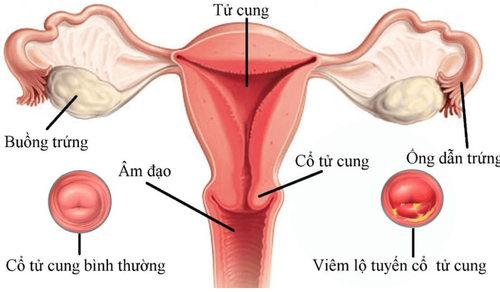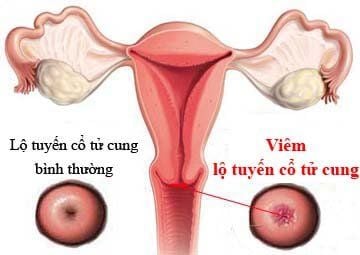This is an automatically translated article.
The article was consulted with Specialist Doctor I Truong Thi Phuong - Doctor of Obstetrics and Gynecology - Obstetrics and Gynecology Department - Vinmec Ha Long International General Hospital.Cervical ectropion occurs when cells from the inside of the cervical canal migrate to the outer surface, forming an glandular area and becoming inflamed. Although this is a completely benign lesion, treatment of cervical ectropion should be aggressive from the beginning, to avoid the risk of malignancy later on. In particular, antibiotics play an important role if the causative agent of inflammation is a microorganism.
1. What is cervical ectropion?
Cervical ectropion is a completely benign, noncancerous condition that occurs when the cells lining the inside of the cervix, which are glandular in nature, migrate outward and form "route area". Because of their less adaptive ability to the acidic vaginal environment than the squamous cells, which line the surface of the cervix and vaginal walls, the ectopic region is more susceptible to inflammation or general irritants.The factor that promotes the formation of cervical ectropion is when estrogen levels are high in the body. This usually happens when a woman has completed puberty and begins to have a sex life. At this time, cervical ectropion is very likely to be acquired, especially during ovulation, during pregnancy and in women taking oral contraceptives. Another possible cause of cervical ectropion is in premenopausal women who are receiving hormone therapy.
Thus, when cervical ectropion is exposed, any external influence can lead to cervical ectropion. Specifically, sources of trauma such as penetrative sex, tampon use, speculum insertion, or insertion of other objects into the vagina. These different types of physical trauma all cause infection and can eventually lead to cervical ectropion.
The causative agents of cervical infection have been reported as staphylococci or streptococcus bacteria. Furthermore, sexually transmitted diseases such as chlamydia, syphilis, and gonorrhea are also significant causes of cervicitis. In addition, less common agents are herpes simplex viruses, trichomonas and genital mycoplasma.
In cases where cervical ectropion is not properly controlled and the chronic inflammation is chronic, prone to dysplasia, the risk of malignancy may occur.
2. What are the symptoms of cervical ectropion?
Most women with cervical ectropion present with a lot of discharge. However, mild cases of inflammation often have no obvious symptoms. Some signs of vaginal discharge in women with cervical ectropion are:
Triệu chứng viêm lộ tuyến cổ tử cung sẽ biểu hiện tùy theo diễn tiến của bệnh
Bleeding during sex. Vaginal bleeding is not a period. Lower abdominal pain. Menstrual disorders. Lack of confidence or decreased sex drive.
3. How to diagnose cervical ectropion?

Người bệnh có thể được chỉ định dùng tampon thấm dịch tiết để tìm tác nhân gây viêm nhiễm
However, because cervical ectropion is a silent disease, this is one of the contents of the routine health check-ups in women, including a cancer screening test. Cervical . Although cervical ectropion is initially completely benign in nature, it has been shown to be associated with an increased risk of developing cervical cancer or other malignancies occurring in the cervical spine. uterus later.
4. Why should antibiotics be used to treat cervical ectropion?
Treatment of cervical ectropion is initially measures to limit the source of estrogen in the body, especially when using exogenous hormones from the outside.If there is evidence that microbial agents cause inflammation in the cervical area, treatment of cervical ectropion now requires the participation of antibiotics according to the detected agent. Oral antibiotics are effective against gonorrhea, chlamydia and T vaginalis. Meanwhile, oral antiviral drugs can help reduce the duration of symptoms, lesions, and kill the virus during the first and recurrent episodes of genital herpes infection.
The antibiotics selected for the treatment of cervical ectropion should have comprehensive antibacterial activity and include all likely pathogens in this setting, eg:
Ceftriaxone and Cefixime are third-generation cephalosporins that are effective in the treatment of general gonococcal urogenital infections. By binding to one or more penicillin-binding proteins, this class of drugs blocks bacterial cell wall synthesis and inhibits bacterial growth. Spectinomycin is an antibiotic that can substitute for cephalosporins in the treatment of gonorrhea. This antibiotic inhibits protein synthesis in bacterial cells. Use Spectinomycin if the patient is allergic to penicillin and quinolones. Do not use spectinomycin if oropharyngeal gonorrhea is suspected. Azithromycin is first-line therapy for chlamydial cervicitis. This antibiotic is a semi-synthetic macrolide antibiotic that is effective in the treatment of chlamydia. Doxycycline is a long-acting tetracycline derived from oxytetracycline. The drug inhibits protein synthesis in bacteria and is effective in the treatment of chlamydia. Metronidazole is a synthetic antibacterial and antitoxic agent. This drug is first-line therapy for vaginal and uterine infections caused by T. vaginalis Levofloxacin inhibits gyrase activity in DNA. This is an alternative treatment for chlamydial cervicitis.

Các kháng sinh được lựa chọn cho việc điều trị viêm lộ tuyến cổ tử cung phải có khả năng kháng khuẩn toàn diện
In addition, if the patient has recurrent cervical ectropion, the ability to control with drugs alone cannot control the disease, the doctor will need to consider combining more intensive treatments such as: Apply silver nitrate or cryotherapy to destroy local inflammatory cells.
However, no matter what measures are taken, during the treatment period, the woman needs to limit certain traumas on this area, including using tampons, cleaning the private area Deep into the vagina or penetrative sex. These things to avoid will help the cervical area heal quickly, stop bleeding and create conditions for cells to increase their resistance better.
In summary, antibiotics for cervical ectropion are necessary if the local presence of pathogenic microorganisms cannot be ruled out. However, in order to effectively treat cervical ectropion, patients need to examine and detect the disease early, choose appropriate drugs as well as combine intervention methods when indicated.
In order to help customers detect and treat other gynecological diseases early, Vinmec International Hospital has a basic gynecological examination and screening package, helping customers detect early inflammatory diseases Easy, inexpensive treatment. Screening detects gynecological cancer (cervical cancer) early even when there are no symptoms.
Basic gynecological examination and screening package for female customers, has no age limit and may have the following symptoms:
Abnormal vaginal bleeding Having menstrual problems: irregular menstrual cycle, irregular menstrual cycle Irregular vaginal discharge (smell, different color) Vaginal pain and itching Female clients have several risk factors such as poor personal hygiene, Unsafe sex, abortion,... Female customers have other symptoms such as: Abnormal vaginal discharge, itching, pain in the private area, abnormal vaginal bleeding.
Please dial HOTLINE for more information or register for an appointment HERE. Download MyVinmec app to make appointments faster and to manage your bookings easily.













